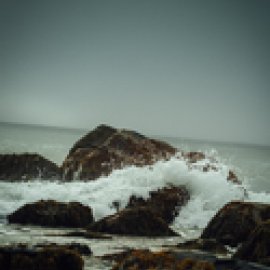Visualizing Success
-
English
-
ListenPause
[intro music, ocean sounds]
I’m Peter Neill, Director of the World Ocean Observatory.
Given the post-pandemic era, and continuing political uncertainty, every institution I know is, or ought to be, in a renewed effort of self-evaluation and strategic planning. It seems ever more urgent to me, even if they went through the process in very recent years. The times they are accelerating, and certainly ‘achanging, and what seemed logical, indeed radical then, should be re-evaluated and re-considered now.
I have been engaged in such processes myself. What I find most interesting, and perturbing, is the reluctance to use the exercise to review purpose, structure, and financial expectations, to challenge all past assumptions and to take a very critical look at intent and program in rapidly changing social and financial landscape. A recent review of ocean funding by major philanthropies shows two significant trends: first, there has been a shift in donor focus from ocean to climate, and, second, there has been a serious aggregation of contributions to one of the many areas of ocean need, specifically in marine protected areas, as if that the only effort that matters most among all the rest.
In the meantime, questions are being raised about the management of these areas, not the ongoing designation, but the supervision, regulation, and financial resources required by many small island nations to maintain the security and quality of sustainability and protection. Intrusion, illegal fishing, coastal pollution, invasive tourism, and other threats remain beyond designation, and where is the necessary funding for that?
There is no question that protecting vast areas of the ocean is a fundamental strategic need; but if we are going to do it right, as with all things, we must provide continuity, resources, and fresh, even radical ideas for success.
Participating in such planning discussions, I have noticed a disturbing tendency toward an exercise that merely re-arranges the elements of the old plan, not really imagining or considering something new or different. The old saying, “rearranging the deck chairs on the Titanic” comes to mind. To challenge that alternative way of approaching the problem meets resistance, allegiance to how it has always been done, and an implicit fear of change, when change is exactly what is needed.
The World Ocean Observatory is not exempt from this natural reaction. The challenge is not just to evolve to a solution, but first to visualize success, to imagine what are the best outcomes from all the possibilities, including the most unexpected, and work backward toward the structure and action plan that will enable the viable, effective change required. The ocean movement has not yet gone through such a process; it is stuck, to some extent immobilized, by working from past strategies and conventions and not understanding that the best way forward may involve something very different and transformational. Experts discussing climate response speak primarily of adaptation and mitigation, and you see that perspective guiding plans for shoreline protection or coastal/freshwater solution. What is missing is “invention.” What is missing is an understanding that on land and sea the challenge is so large and urgent that the old ways may already be overwhelmed, only to be vulnerable again. Repair the dock, expand the culvert, re-build the seawall and the bridge – all these approaches are familiar and underway around us. But what about re-designing the dock, lifting the road, moving to higher ground the vulnerable facilities the seawall was meant originally to protect, replacing the fixed causeway with a floating bridge, or any other imaginative, alternative actions enabled by new technology and the certainty that the destructive circumstance recently experienced will inevitably come again, with equal, indeed greater force and destruction. Too little too late does not fease. And in that failure, we are sadly complicit.
The future is not determined unless we make it so. To succeed in this challenging moment, we need to invent, to imagine new ways forward, to take risk to avoid risk, and to have faith that if we have confidence in our ability to solve problems through energy and imagination, and act accordingly, the problems will be solved.
We will discuss these issues, and more, in future editions of World Ocean Radio.
WORLD OCEAN RADIO IS DISTRIBUTED BY THE PUBLIC RADIO EXCHANGE AND THE PACIFICA NETWORK, FOR USE BY COLLEGE AND COMMUNITY RADIO STATIONS WORLDWIDE. FIND US WHEREVER YOU LISTEN TO PODCASTS, AND AT WORLD OCEAN OBSERVATORY DOT ORG, [WHERE THE FULL CATALOG OF MORE THAN 700 RADIO EPISODES IS SEARCHABLE BY THEME.]
[outro music, ocean sounds]
As we discuss resiliency, adaptation, and mitigation of climate and ocean, we must also invent--not to merely rearrange the elements of an old plan, but to imaging and consider some things new and different. If the ocean movement is to embrace the change required to respond to challenges worldwide, we must imaging new ways forward, confident in our abilities to solve problems through imagination, action, and energetic response.
About World Ocean Radio
World Ocean Radio is a weekly series of five-minute audio essays available for syndicated use at no cost by college and community radio stations worldwide. Peter Neill, Director of the World Ocean Observatory and host of World Ocean Radio, provides coverage of a broad spectrum of ocean issues from science and education to advocacy and exemplary projects.
World Ocean Radio
14 Years, 700+ Episodes
Ocean is climate
Climate is ocean
The sea connects all things
- Login to post comments



